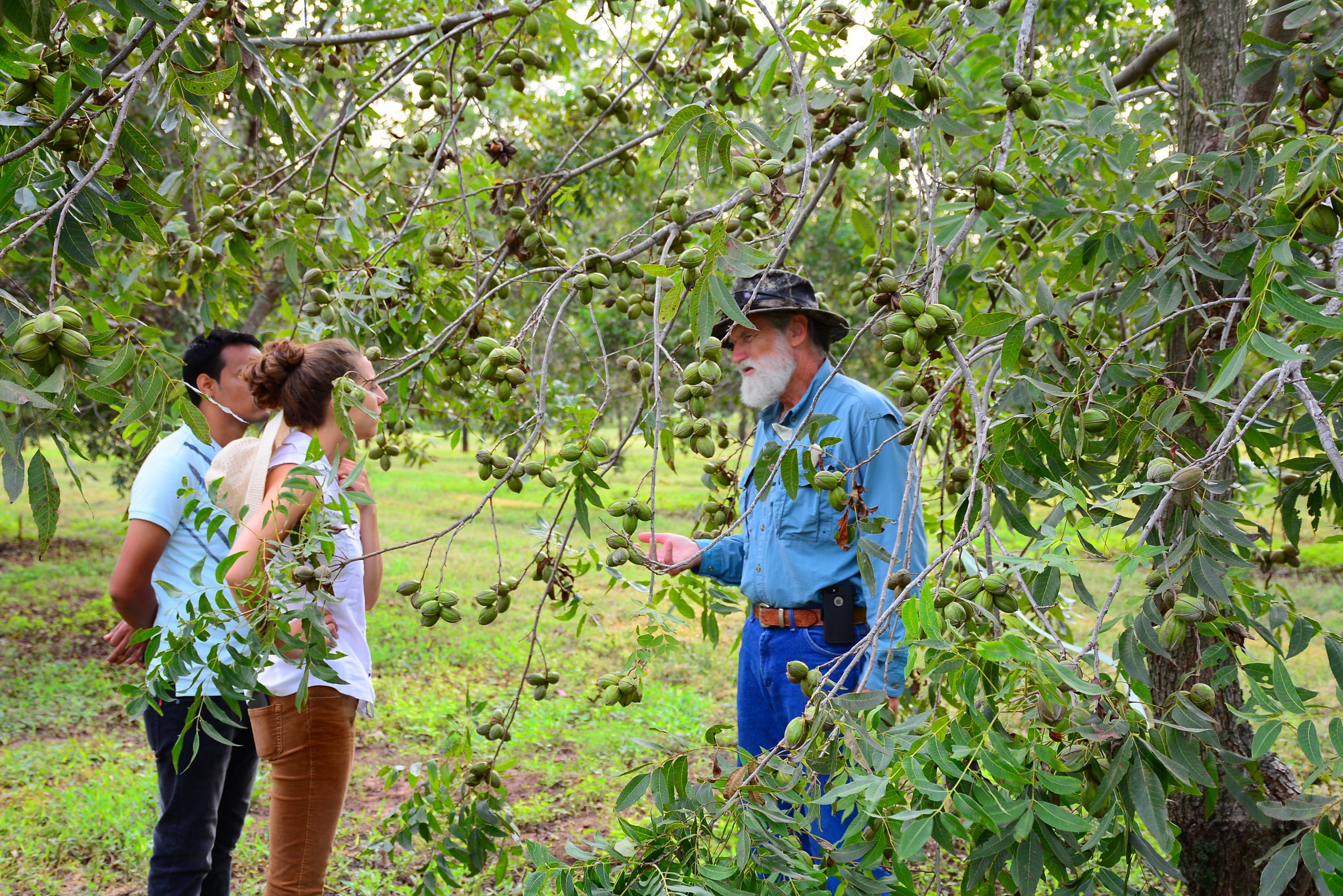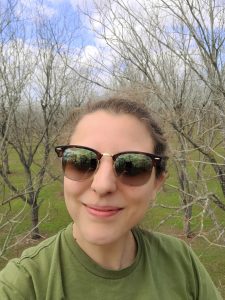Meet the New USDA-ARS Plant Pathologist
Dr. Angelyn Hilton shares her journey in pecan.

In this archived photo, Dr. LJ Grauke speaks with Drs. Angelyn Hilton and Xinwang Wang in one of the experimental pecan orchards at the USDA ARS Pecan Breeding Station in Somerville, Texas. This photo is from when Hilton first started in pecan. (Photo courtesy of Angelyn Hilton)
What I did have, though, was a fascination with biology. Our earth, and all the beauty that lies within it, is a masterpiece created by God. I felt driven to uncover its mysteries, to serve something greater than myself. As such, I decided to pursue my Bachelor’s in Bioenvironmental Science at Texas A&M University. Within my major’s core curriculum, I took a number of courses in plant sciences. It was where I first learned of the devastating nature of plant diseases, and it quickly became my rallying cry. I pursued my Master’s and Ph.D. in Plant Pathology, hoping to help preserve one of our main sources of survival—plants.

Dr. Angelyn Hilton in one of the pecan orchards at the USDA ARS Breeding Station in Somerville, Texas. (Photo courtesy of Angelyn Hilton)
I began my pecan journey in 2016 when Dr. LJ Grauke, the pecan Horticulturist (now retired) at the USDA ARS National Collection of Genetic Resources for Pecans and Hickories (NCGR-Carya) and the Pecan Breeding and Genetics Program, reached out to Dr. Young-Ki Jo at Texas A&M University about an emerging disease threat to pecan health and distribution. The pathogen, Xylella fastidiosa, is a heavily-quarantined bacteria that causes Pecan Bacterial Leaf Scorch. As a Ph.D. student, I had the opportunity to work at NCGR-Carya with Dr. LJ Grauke, Dr. Xinwang Wang, Dr. Clive Bock from the USDA Southeastern Fruit and Tree Nut Research Laboratory (SEFTNL) in Georgia, and Dr. Jennifer Randall from New Mexico State University, and with funding from the USDA NIFA SCRI ‘Coordinated development of Genetic Tools for Pecan.’
I believe that God charts our paths in life, and through the last seven years, He has continued to lead me back to the pecan industry and the supportive scientific and agricultural community it fosters. I finished my Ph.D. in May 2020 during the height of the COVID-19 pandemic. I didn’t know what I was going to do, so I prayed for guidance. It wasn’t long after that a close friend called to tell me that there was a job opening for a technician position at the USDA ARS Pecan Breeding and Genetics Program. I may have been slightly overqualified, but when that opportunity presented itself, I knew in my heart that I needed to pursue it.
I quickly moved up from that technician position to a temporary postdoctoral scientist and, recently, was hired as the official Research Plant Pathologist for the USDA ARS Pecan Breeding and Genetics Program. My hire—along with the hires of our Lead Scientist and Geneticist, Dr. Warren Chatwin, Geneticist and Breeder, Dr. Xinwang Wang, Repository Curator, Keith Kubenka, and Research Science Technician, Braden Tondre—comes at a turning point for our program and for pecan research as a whole. Major funding increases have led to the maintenance and expansion of our facilities, resources, and personnel at a time when significant scientific advancements are being made toward developing genetics tools for pecan. Moving forward, our collective goal is to guarantee that these research investments yield direct benefits for producers.
Pecan producers encounter numerous challenges in maintaining their crop and navigating a dynamic agricultural landscape shaped by climatic uncertainties such as drought, heat stress, wind, freeze damage, and flooding. Additionally, the constant threat of diseases and pests further jeopardizes tree health. The swift evolution of pathogens underscores the essential role of continuous efforts by breeders and pathologists in developing new breeding lines to ensure pecan trees’ resilience and adaptability in the face of emerging challenges.
From a pathologist’s standpoint, a myriad of disease issues demands sustained attention, both in the present and the foreseeable future. In the subsequent sections, I will elaborate on some of the most impactful diseases, elucidate our ongoing objectives and projects, and provide insight into my vision for the trajectory of research in the years to come.
Pecan Bacterial Leaf Scorch (PBLS)
Pecan Bacterial Leaf Scorch, attributed to the bacteria Xylella fastidiosa, poses a significant challenge to the pecan industry. Its prevalence spans California, Arizona, New Mexico, Texas, Louisiana, and Georgia. Pecan Bacterial Leaf Scorch cannot be cured, and although certain cultivars display varying degrees of susceptibility, there are no known sources of resistance. Symptoms manifest as light tan to brown lesions on leaves, resembling burn damage or drought stress. Premature defoliation, induced by the disease, can diminish photosynthesis and overall yield.
The bacteria reside within the plant’s vascular system and are transmitted by xylem-feeding insects, grafting of infected scions or rootstocks, and, recently discovered, through pecan nuts to seedlings. In particular, the discovery of seed transmission underscores fundamental questions about the coevolutionary dynamics between pecans and the pathogen. The entry points of the bacteria into the nut and potential risk factors remain elusive. Our ongoing efforts involve tracking the bacteria within mature trees and nuts throughout the growing season, employing molecular and microscopy techniques.
The impact of Pecan Bacterial Leaf Scorch varies from year to year. The reasons behind these inconsistencies in disease expression remain unclear. One hypothesis suggests that tree stress triggers the bacteria to become pathogenic, akin to the reactivation of the shingles virus under compromised immune conditions in humans. Our latest endeavors focus on identifying stressors to provide enhanced recommendations for disease management. Collaborating with Texas A&M and New Mexico State Universities, we are investigating the effects of heat and drought stress on Xylella-infected trees, with preliminary data suggesting a significant role of heat stress in symptom onset.
Pecan Scab
Caused by the fungus Venturia effusa, Pecan Scab threatens unmanaged orchards with susceptible cultivars and can result in total yield losses. Scab spores, spread by wind and rain, infect both leaves and nuts. Control costs are high, and the pathogen’s growing resistance to fungicides continues to limit treatment options. Breeding Scab-resistant cultivars remains a primary strategy for combatting the disease.
Unfortunately, resistance in some cultivars has diminished over time or has not been translated across all regions of pecan production. Addressing this issue involves improving evaluations of breeding material for disease severity and considering the diversity within pathogen populations across locations. Over the next several years, we will be working directly with pecan industry representatives to distribute breeding material across the country so that they can be properly monitored under different levels of disease pressure to determine which new cultivar releases will be best for that particular growing region.
Research has shown that there exist different races of the Scab pathogen, which is a way of classifying groups within the fungal population. These races often exhibit specificity to both geographic locations and pecan cultivars. Yet, the mechanisms by which these races adapt and progressively intensify in aggressiveness remain poorly understood. The implementation of controlled infections, coupled with more reliable, consistent observations of Scab severity within NCGR-Carya, will enable us to delve deeper into the intricate dynamics of how genetics influence the interactions between the host and the pathogen.
Other issues Related to Tree Health
Several pecan diseases, such as Pecan Leaf Dieback, Zonate Leaf Spot, Downy Spot, and Anthracnose, warrant more comprehensive exploration, especially from a breeding perspective. While these diseases may go unnoticed with an effective spray program, the development of fungicide resistance remains a concern. Furthermore, consumers’ increasing demand for organic pecans prevents producers from utilizing chemical treatment options when disease outbreaks occur. Testing different disease pathogens, including those mentioned, on currently available and future cultivar releases is a key goal to determine susceptibility levels over the next several years.
Lastly, adopting a holistic approach is crucial for comprehending tree health. Stressed trees are more susceptible to physiological disorders and diseases induced by microbial pathogens. A comprehensive understanding of temperature, salt damage, and drought stress effects on pecan physiology is imperative. These endeavors will pave the way for advancements in rootstock breeding in conjunction with the advent of pecan tissue culture techniques. The ongoing development of novel rootstock varieties tailored to specific soil and environmental conditions remains paramount for ensuring the enduring survival and health of pecans.
The subjects covered in this article serve as just a glimpse into the ongoing progress of pecan pathology research at the USDA ARS Pecan Breeding and Genetics Program. As I venture into the forthcoming phases of pecan pathology research, I remain committed to giving producers my undivided attention. Your concerns and questions are invaluable, and I encourage you to reach out to me directly without hesitation. My unwavering dedication to serving the pecan industry is fueled by passion, and I recognize that the success of my role, our program enhancements, and the scientific strides achieved in pecan are all indebted to the unwavering support of our industry.

